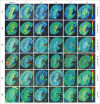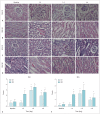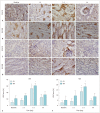Evaluation of Renal Pathophysiological Processes Induced by an Iodinated Contrast Agent in a Diabetic Rabbit Model Using Intravoxel Incoherent Motion and Blood Oxygenation Level-Dependent Magnetic Resonance Imaging
- PMID: 30993934
- PMCID: PMC6470079
- DOI: 10.3348/kjr.2018.0757
Evaluation of Renal Pathophysiological Processes Induced by an Iodinated Contrast Agent in a Diabetic Rabbit Model Using Intravoxel Incoherent Motion and Blood Oxygenation Level-Dependent Magnetic Resonance Imaging
Abstract
Objective: To examine the potential of intravoxel incoherent motion (IVIM) and blood oxygen level-dependent (BOLD) magnetic resonance imaging for detecting renal changes after iodinated contrast-induced acute kidney injury (CI-AKI) development in a diabetic rabbit model.
Materials and methods: Sixty-two rabbits were randomized into 2 groups: diabetic rabbits with the contrast agent (DCA) and healthy rabbits with the contrast agent (NCA). In each group, 6 rabbits underwent IVIM and BOLD imaging at 1 hour, 1 day, 2 days, 3 days, and 4 days after an iohexol injection while 5 rabbits were selected to undergo blood and histological examinations at these specific time points. Iohexol was administrated at a dose of 2.5 g I/kg of body weight. Further, the apparent transverse relaxation rate (R2*), average pure molecular diffusion coefficient (D), pseudo-diffusion coefficient (D*), and perfusion fraction (f) were calculated.
Results: The D and f values of the renal cortex (CO) and outer medulla (OM) were significantly decreased compared to baseline values in the 2 groups 1 day after the iohexol injection (p < 0.05). A marked reduction in the D* values for both the CO and OM was also observed after 1 hour in each group (p < 0.05). In the OM, a persistent elevation of the R2* was detected for 4 days in the DCA group (p < 0.05). Histopathological changes were prominent, and the pathological features of CI-AKI aggravated in the DCA group until day 4. The D, f, and R2* values significantly correlated with the histological damage scores, hypoxia-inducible transcription factor-1α expression scores, and serum creatinine levels.
Conclusion: A combination of IVIM and BOLD imaging may serve as a noninvasive method for detecting and monitoring CI-AKI in the early stages in the diabetic kidney.
Keywords: Hypoxia-inducible transcription factor-1α; Medullary hypoxia; Renal vascular dysfunction; Vascular endothelial growth factor.
Copyright © 2019 The Korean Society of Radiology.
Conflict of interest statement
The authors have no potential conflicts of interest to disclose.
Figures









Similar articles
-
Blood Oxygen Level-Dependent Imaging and Intravoxel Incoherent Motion MRI of Early Contrast-Induced Acute Kidney Injury in a Rabbit Model.Kidney Blood Press Res. 2019;44(4):496-512. doi: 10.1159/000500052. Epub 2019 Jun 28. Kidney Blood Press Res. 2019. PMID: 31256149
-
Application of Blood Oxygenation Level-Dependent Magnetic Resonance Imaging and Intravoxel Incoherent Motion to Assess Bilateral Renal Pathophysiological Processes Induced by Iodixanol Renal Artery First-Pass in Rabbit Model.J Comput Assist Tomogr. 2019 Jul/Aug;43(4):634-640. doi: 10.1097/RCT.0000000000000870. J Comput Assist Tomogr. 2019. PMID: 31162241
-
Application of diffusion tensor imaging and blood oxygenation level-dependent magnetic resonance imaging to assess bilateral renal function induced by Iohexol in rabbits.BMC Nephrol. 2020 Jun 3;21(1):210. doi: 10.1186/s12882-020-01857-y. BMC Nephrol. 2020. PMID: 32493274 Free PMC article.
-
Functional Magnetic Resonance Imaging in Acute Kidney Injury: Present Status.Biomed Res Int. 2016;2016:2027370. doi: 10.1155/2016/2027370. Epub 2016 Jan 26. Biomed Res Int. 2016. PMID: 26925411 Free PMC article. Review.
-
Methods of Blood Oxygen Level-Dependent Magnetic Resonance Imaging Analysis for Evaluating Renal Oxygenation.Kidney Blood Press Res. 2018;43(2):378-388. doi: 10.1159/000488072. Epub 2018 Mar 8. Kidney Blood Press Res. 2018. PMID: 29539614 Review.
Cited by
-
Research progress on animal models of contrast-induced acute kidney injury.Zhong Nan Da Xue Xue Bao Yi Xue Ban. 2023 Apr 28;48(4):594-600. doi: 10.11817/j.issn.1672-7347.2023.220608. Zhong Nan Da Xue Xue Bao Yi Xue Ban. 2023. PMID: 37385622 Free PMC article. Chinese, English.
-
Biomarkers in Contrast-Induced Nephropathy: Advances in Early Detection, Risk Assessment, and Prevention Strategies.Int J Mol Sci. 2025 Mar 21;26(7):2869. doi: 10.3390/ijms26072869. Int J Mol Sci. 2025. PMID: 40243457 Free PMC article. Review.
-
Using intravoxel incoherent motion imaging to evaluate uric acid-induced renal injury and efficacy after treatment.Br J Radiol. 2024 Jan 23;97(1153):274-282. doi: 10.1093/bjr/tqad037. Br J Radiol. 2024. PMID: 38263841 Free PMC article.
-
Assessment of Acute Kidney Injury using MRI.J Magn Reson Imaging. 2025 Jan;61(1):25-41. doi: 10.1002/jmri.29281. Epub 2024 Feb 9. J Magn Reson Imaging. 2025. PMID: 38334370 Free PMC article. Review.
-
Noninvasive diagnosis of interstitial fibrosis in chronic kidney disease: a systematic review and meta-analysis.Ren Fail. 2024 Dec;46(2):2367021. doi: 10.1080/0886022X.2024.2367021. Epub 2024 Jun 28. Ren Fail. 2024. PMID: 38938187 Free PMC article.
References
-
- McCullough PA. Contrast-induced acute kidney injury. J Am Coll Cardiol. 2008;51:1419–1428. - PubMed
-
- Stacul F, van der Molen AJ, Reimer P, Webb JA, Thomsen HS, Morcos SK, et al. Contrast Media Safety Committee of European Society of Urogenital Radiology (ESUR) Contrast induced nephropathy: updated ESUR Contrast Media Safety Committee guidelines. Eur Radiol. 2011;21:2527–2541. - PubMed
-
- Chalikias G, Drosos I, Tziakas DN. Contrast-induced acute kidney injury: an update. Cardiovasc Drugs Ther. 2016;30:215–228. - PubMed
Publication types
MeSH terms
Substances
LinkOut - more resources
Full Text Sources
Medical

